Carbohydrates are polyhydroxy aldehydes or ketones
Carbohydrates are the most abundant bio-macro-molecules on the earth. They are commonly known as sugars because most of them have a sweet taste. Chemically all carbohydrates are polyhydroxy (contain many hydroxyl, – OH, groups) aldehydes or ketones. All carbohydrates are hydrates of carbon and they contain C, H and O. The ratio of hydrogen and oxygen in the majority of carbohydrates will be in 2:1 as in water. Some carbohydrates also contain nitrogen, phosphorous and sulfur.
Majority of carbohydrates, not all, have the empirical formula (CH2O)n. In biochemistry, carbohydrates are denoted as saccharides. The term saccharide is derived from a Greek word ‘sakkharon’ meaning sugar. Green plants fix the energy of sunlight by photosynthesis. In photosynthesis, the light energy is converted into the chemical energy and it is stored in some carbohydrates such as glucose, fructose, sucrose, starch etc. The oxidative breakdown of these carbohydrates by respiration release the energy stored in them and this energy is utilized for the various metabolic activities of the cells.
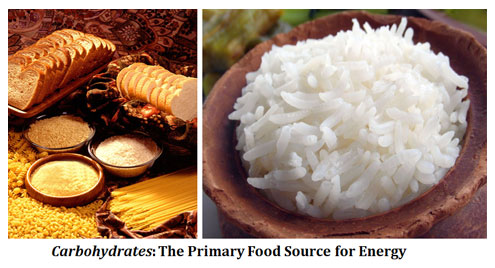 Carbohydrates are classified into THREE major categories:
Carbohydrates are classified into THREE major categories:
Carbohydrates are classified into three major categories based on the number of monomer units and the degree of their polymerization. They are:
(1). Monosaccharides
(2). Oligosaccharides
(3). Polysaccharides
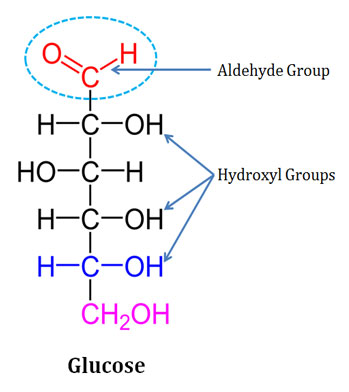 (1). Monosaccharides
(1). Monosaccharides
Monosaccharides, also called simple sugars, are the basic unit of carbohydrates. They are the fundamental unit of carbohydrates and they cannot be further hydrolyzed to yield smaller carbohydrate units. All monosaccharides consist of a single polyhydroxy aldehyde or ketone unit. Most of the monosaccharides have the empirical formula C(H2O)n. Monosaccharides exists as colourless, crystalline and water soluble solids. Most of the monosaccharides have sweet taste. All monosaccharides are reducing sugars.
On the basing of the number of carbon atoms, the monosaccharides may be triose (with 3C), tetrose (4C), pentose (5C) or hexose (6C). Monosaccharides with four or more carbon atoms tend to have cyclic structures in the nature. The scientific nomenclature of monosaccharides is very complex. However, the common names of most of the monosaccharides end with a suffix ‘ose’. The most abundant monosaccharide in the nature is a six carbon sugar called glucose.
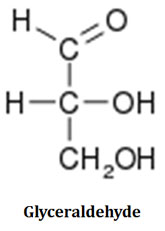 Examples of monosaccharides
Examples of monosaccharides
3 Carbon – Dihydroxy acetone
4 Carbon – Erythrose
5 Carbon – Ribose
6 Carbon – Glucose, Fructose
You may also like NOTES in...
BOTANY BIOCHEMISTRY MOL. BIOLOGY
ZOOLOGY MICROBIOLOGY BIOSTATISTICS
ECOLOGY IMMUNOLOGY BIOTECHNOLOGY
GENETICS EMBRYOLOGY PHYSIOLOGY
EVOLUTION BIOPHYSICS BIOINFORMATICS
(2). Oligosaccharides
The oligosaccharides are sugar polymers consist of short chains of monosaccharide units (residues). The monosaccharide units in the polysaccharide chain are linked through a characteristic bond called glycosidic bond. The number of monomer units in the oligosaccharides usually range from 2–20. All oligosaccharides on hydrolysis yield individual monosaccharide units due to the cleavage of the glycosic bonds.
The most common oligosaccharides in the nature are disaccharides. A disaccharide consists of two monosaccharide units. The most abundant naturally occurring disaccharide is sucrose (table sugar). Sucrose consists of a glucose residue and a fructose residue connected through α-1-2 glycosidic linkage. Oligosaccharides with three or more monosaccharide units do not occur freely in the nature. They are usually found associated with non-sugar molecules such as proteins and lipids as glyco-conjugates (Glycoproteins, Proteoglycans and Glycolipids).
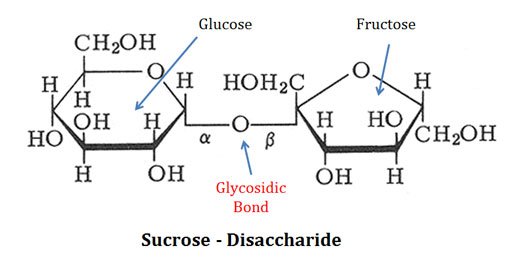 Examples of oligosaccharides:
Examples of oligosaccharides:
(a). Sucrose: a disaccharide of glucose and fructose
(b). Lactose: a disaccharide of galactose and glucose
(c). Maltose: a disaccharide of two glucose residues
(d). Trehalose: a disaccharide of two alpha linked glucose residues
(e). Raffinose: a trisaccharide of galactose, glucose, and fructose
(3). Polysaccharides
They are complex sugar polymers with more than 20 monosaccharide units. Most of the naturally occurring polysaccharides have more than 1000 monosaccharide units. Like oligosaccharides, the monomer units in the polysaccharides are also linked through glycosidic bonds. Polysaccharides on hydrolysis release the individual building monosaccharide units. Some polysaccharide chains are un-branched while some other as heavily branched. Polysaccharides are further classified into two categories based on its composition of monosaccharide residues in the chain. They are:
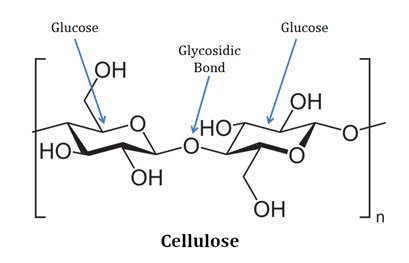 (1). Homopolysaccharides: They composed of only a single type of monosaccharide unit.
(1). Homopolysaccharides: They composed of only a single type of monosaccharide unit.
(2). Heteropolysaccharides: They composed of more than one type of monosaccharide units.
Examples of polysaccharides
Homopolysaccharides: Starch, Glycogen and Cellulose (monosaccharide units in all three are glucose)
Heteropolysaccharide: Peptidoglycan, Chondroitin, Heparin
Biological significance/functions of carbohydrates:
Ø Source of energy: Carbohydrates are the primary source of energy. They are the food reserve (energy store molecules) in microbes, animals and plants.
Ø Source of C, H, and O: Carbohydrates also act as the source of C, H and O in the cells for the synthesis of other macro molecules.
Ø Sweetener: Some sugars are sweet in taste. They provide sweetness and flavor to a variety of food stuffs.
Ø Glycolipids: Carbohydrate containing lipids (called glycolipids) are one of the important categories of plasma membrane lipids.
Ø Dietary fibres: Carbohydrates are also the source of dietary fibres.
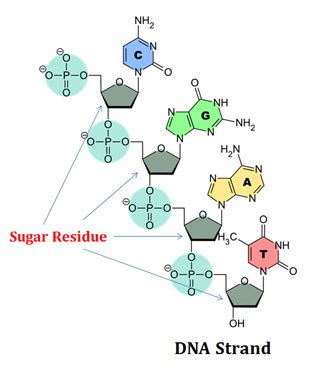 Ø Ribose sugar: A monosaccharide (ribose) is an essential component in the genetic material (DNA and RNA).
Ø Ribose sugar: A monosaccharide (ribose) is an essential component in the genetic material (DNA and RNA).
Ø Cell wall and exoskeleton: Some carbohydrates from the structural framework of the cells. For example, cellulose from the cell wall of plants, Peptidoglycan forms the cell wall of bacterial cells and chitin forms the cell wall of fungi and the exoskeleton of arthropods.
| You may also like... | ||
|---|---|---|
| NOTES | QUESTION BANK | COMPETITIVE EXAMS. |
| PPTs | UNIVERSITY EXAMS | DIFFERENCE BETWEEN.. |
| MCQs | PLUS ONE BIOLOGY | NEWS & JOBS |
| MOCK TESTS | PLUS TWO BIOLOGY | PRACTICAL |
Ø Recognition: Some carbohydrates on the surface of cell membrane have recognition role.
Ø Protein trafficking: The glycosylation (attachment of sugar moieties to other macromolecules such as proteins) of proteins are used in protein-trafficking by the cell. Example: a protein tagged with mannose 6-phosphate is destined to lysosome.
Ø Anticoagulant: Heparin, the anticoagulant of the blood, is a carbohydrate which prevents the blood clotting.
Ø Blood group: The ABO blood groups are determined by the carbohydrates and thus carbohydrates also functions as antigens.
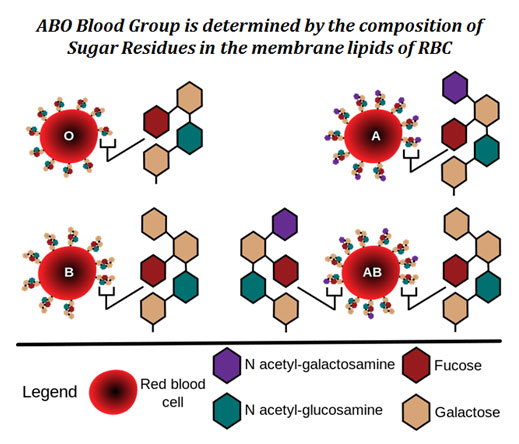
Ø Industrial uses: Some carbohydrates are the raw material for many industries. Example: cellulose in the paper industry, starch, glucose, fructose etc. in fermentation and brewing industry.
You might also like…
@. Monosaccharides: Properties, Structure and Classification
@. Glycoconjugates: (Glycoprotein, Proteioglycan and Glycolipids)
@. Membrane Lipids: Properties, Structure and Classification
@. MCQ on Carbohydrates: Part 1 | Part 2 | Part 3 |

Respected sir,
how to down load material
I want mutarotation portion
we will update soon
It is understandable
Hi Sir/Mam
Thank you for the give such a good mater on carbohydrates . But I did not get the full… How can I see the whole matter?
Thank you deep
the rest of the portions will be updated soon
keep visiting easybiologyclass
EBC IS A WORLD CLASS OF KNOWLEDGE HOUSE. THANK YOU-EBC. I ALWAYS RECOMMEND MY ALL FRDS..
DEAR SIR/MAM,
CAN I GET NOTES ON CARBOHYDRATE METABOLISM??. IF YOU HAVE PLEASE SHARE ME.. 🙌🙌
Dear mam / sir
My question is Nitrogen bases are hydrophobic . But what is the benefit of this nature of nitrogen base in nucleic acid.
Pls give me answer.
Dear Kiran
Thank you for visiting Easybiologyclass
All these hydrogen bonds in DNA are strengthened and protected from solvent hydration by the hydrophobic stacking of the bases, which is a major contributor to the helix stability. Without such protective stacking, the base pairs would rapidly separate and hydrate with solvent water.
In conclusion: the usual symmetry, and helical conformation of DNA is maintained due to the hydrophobic nature of bases in the DNA.
Hope it is clear
Regards
Dear mam / sir
My question is Nitrogen bases are hydrophobic . But what is the benefit of this nature of nitrogen base in nucleic acid.
Pls give me answer.
Dear Madam/Sir, very nice information on Carbohydrates. Thank you very much
Thank you
Understandable and self explanatory, thump up!